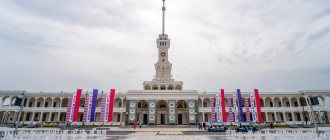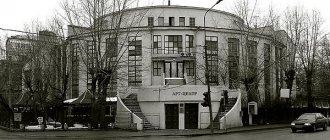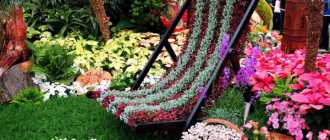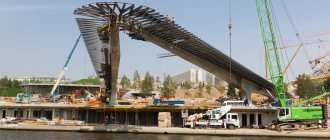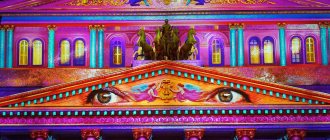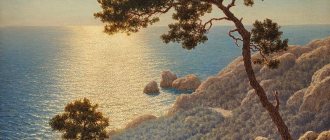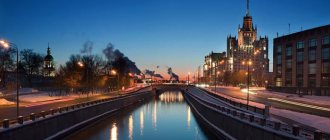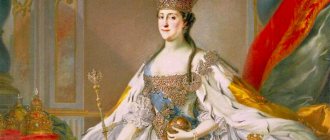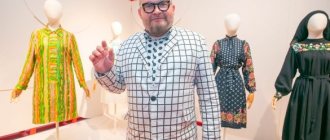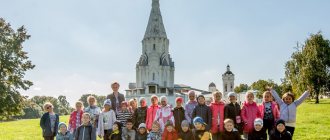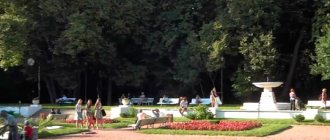Located next to Red Square near the Kremlin wall Alexander Garden in Moscow was created in 1812 by order of Alexander I, as a symbol of the revival of Moscow after Napoleon's invasion in 1812. It is divided into Upper, Middle and Lower gardens.
At first it was called the Kremlin Gardens, then the Alexander Gardens. The Alexander Gardens were named after Alexander II after his coronation.
Alexander Garden in Moscow
Nearest metro stations: Aleksandrovsky Sad, Lenin Library, Borovitskaya.
The Alexander Garden in Moscow was designed by the architect Osip Bove on the site of the Neglinnaya River. The river for 3 kilometers was removed into an underground pipe. Above it is a garden between Manezhnaya Street and the Kremlin wall. Now only the Trinity Bridge, spanned between the Kutafya and Trinity towers, reminds of the river.
The garden covers an area of 10 hectares. The Upper Garden extends to the Trinity Bridge, its length is 350 meters. The middle garden stretches 382 meters from the Trinity to the Borovitskaya tower. It contains ticket offices for the Kremlin museums and the entrance to the Kremlin territory through the Kutafya Tower. The Lower Garden is located from the Borovitskaya Tower to the embankment, its length is 132 meters, and is closed to visitors.
The Alexander Garden is a wonderful place for a walk in the very center of the capital, near the ancient Kremlin walls and among many historical attractions. The garden is beautiful at any time of the year, but is especially beautiful during the flowering period: tulips, roses, pansies, and lilacs delight the eye. This is a great place for photography.
One and a half kilometers from the Alexander Garden, behind Red Square, there is Zaryadye Park with a floating bridge, an ice cave and other interesting objects.
History of creation: 18th century – Admiralty Meadow
The process of formation of the Alexander Garden was quite long. After the Admiralty Fortress lost its military purpose, the glacis was partially used for storing ship building materials, and partially occupied by the Marine Market
.
Its unused places were overgrown with grass, turning into the Admiralty Meadow
, on which cattle grazed. In the first half of the 19th century, Admiralty Meadow was of gigantic proportions - it occupied the territory of what is now Palace Square, Alexander Garden and Senate Square.
But the city grew, was built up, Nevsky Prospekt was created, which began precisely from the Admiralty buildings. Already under Peter the Great, a rough plan for the development of the city was drawn up, according to which two straight lines of avenues ran from the Admiralty ( Nevsky and Voznesensky
), cutting through the meadow territory.
By order of Peter the Great, the Admiralty Meadow along Nevsky Prospect, to give it a more presentable and noble appearance, was decorated with a birch alley
planted by the hands of captured Swedes.
Alley of Nevsky Prospekt on Admiralteysky Meadow
But, nevertheless, until the end of the 18th century, meadow lands were used for various purposes: folk festivals
festive
festivities
at the royal expense,
military exercises
, storage of building materials and, until the entire meadow was covered with pavement,
cattle
grazed .
Meanwhile, around the Admiralty Meadow, structures grew up that later became the most monumental symbols of the city - the Winter Palace was erected (mid-18th century), St. Isaac's Cathedral was built (early 19th century), the Bronze Horseman (architect) appeared on the territory of the western glacis of the Admiralty in 1782 .Yu.Falcone).
Thus, the gradual formation of three squares began: Dvortsovaya, Senate and St. Isaac's. The territory of Admiralteysky Meadow between them began to take shape as a green urban area.
First half of the 19th century – Admiralteysky Boulevard
At the beginning of the 19th century, designed by architect L. Ruska
a walking boulevard
with green benches and oil lanterns was formed The territory of the walking area was fenced with a wooden fence, and the entrances were equipped with revolving turnstiles, guarded by sentries. Vacationers could take a walk in the beautifully landscaped park area, sit in a coffee or tea house.
Admiralteyskaya Square and Admiralteysky Boulevard of St. Petersburg in the 18th century
The boulevard's alleys were landscaped by gardener W. Gould
. All planted young viburnums, mountain ash, oaks, honeysuckle and other trees were equipped with supports and signs with the year of planting. The flowers planted on Admiralteysky Boulevard were brought from the garden of the Catherine Palace of Tsarskoe Selo.
By 1824
The boulevard between the Winter Palace and the Admiralty continued to the Palace Pier, and the filled-in Admiralty Canal was transformed into a linden alley.
A little later, the garden was decorated with marble copies of the ancient sculptures “ Hercules
of Farnese” and “
Flora
of Farnese” (1833).
Sculpture of Hercules in the Alexander Garden
The remaining part of Admiralteysky Meadow became Admiralteyskaya Square
, which existed until
1872
, when the combined territories of the square and the boulevard were transformed into a city garden.
Second half of the 19th century – Alexander Garden
The idea of creating a garden belonged to the City Duma in 1872
in connection with
the 200th anniversary of Peter
the Great.
At the same time, the gardening of the territory began under the leadership of the St. Petersburg botanist E. Regel
.
The work on organizing the garden area on the site of the former boulevard and square was truly gigantic. More than five thousand trees alone were planted, and more than 12 thousand specimens
. Most of the plantings, as was customary in those days, were accompanied by nameplates.
Cast iron benches appeared in the garden area, and the entire garden was surrounded by a lattice. At the grand opening of the garden on July 8, 1874
Emperor
Alexander II,
in front of a large gathering of invited people, personally planted a young oak tree.
Those who were unable to attend the gala event watched all the events taking place from behind the garden fence. At the suggestion of the State Duma, the new city garden was given the name Alexandrovsky
, in honor of Alexander the Second, who did not object to this.
Alexander II plants an oak tree in the Alexander Garden
After the official opening of the garden, work on its improvement
continued.
Throughout the garden area, many pavilions
, greenhouses,
greenhouses
and trade
kiosks
, in which merchants sold various drinks and sweets in the summer.
verandas
were built to protect from the rain .
Soon a fountain
in a pre-prepared place (
architect A. Geschwend
) - opposite the main Admiralty tower.
In 1879, on October 13
, the fountain was solemnly launched.
During the summer, the music
of a military orchestra sounded in the garden.
In the evenings, the garden was illuminated by lanterns
such as floor lamps.
Fountain of the Alexander Garden
But the improvement didn’t end there either. The State Duma decided to install several busts of the most famous Russian writers in the Alexander Garden. There were many candidates. The list included Cyril and Methodius, and the names of Karamzin, Pushkin, Lermontov and many others. Opinions regarding the proposed candidates changed several times. Eventually, the first bust took its place. It was an image of V. Zhukovsky
- mentor and educator of Alexander II.
The installation of the bust of Zhukovsky on July 4, 1887
was timed to coincide with the 100th anniversary of the poet’s birth.
Bust of V. Zhukovsky
In 1892
The next bust appears - the famous
traveler N. Przhevalsky
.
On its granite pedestal there was also a place for a Central Asian camel
.
Bust of Przhevalsky
Lermontov, Gogol and Glinka appeared next to the fountain.
.
First half of the 20th century – M. Gorky Garden of Workers
It must be borne in mind that the Alexander Garden was initially located on all sides of the Admiralty. But by the end of the 19th - beginning of the 20th century
its eastern part was replaced by a new city highway -
Palace Passage
, which ran between the Admiralty buildings and the Winter Palace.
Palace passage between the Admiralty and the Winter Palace (art. Vereshchagin)
To the west of the Admiralty, in the overgrown gardens, the Bronze Horseman somehow got lost. Therefore, since the end of the 19th century
The area near the monument to Peter the Great began to be reconstructed - the garden area was
limited
to the area with the monument to Peter the Great.
The reconstruction also affected the main garden part along Admiralteysky Proezd. It was decided to cut paths and alleys in the overgrown garden area, but they did not have time to do this. The dilapidated buildings were only demolished and rose gardens
and other flower beds.
In 1907
It was from the Alexander Garden along Admiralteysky Prospekt that the first tram was launched, and then bus service began. The memorial paving slab reminds of the beginning of urban transport from this very place.
Memorial plaque commemorating the launch of the first tram
After the revolution, in 1923
The pre-revolutionary decision to organize alleys was implemented.
New
clearings
were cut , many old buildings were destroyed, the geometric shape of paths and lawns was changed, and children's and sports grounds appeared.
The garden itself was renamed the Garden of Workers
, and after the death of the writer
M. Gorky in 1936,
the garden was given his name.
During the Great Patriotic War
anti-aircraft installations
were located in the garden area . The garden suffered greatly from fascist bombing, but residents of besieged Leningrad spared the famous garden and did not cut down its trees for firewood.
Flower Festival in the Alexander Garden
, flower exhibitions began to be held there.
and other gardening events.
Second half of the 20th century
In the 70s of the 20th century, instead of the previous garden fence, a pink granite parapet
.
The entrances were decorated with pedestals with granite hemispheres. And the alleys were decorated with antique cast-iron anchors on pedestals. By the end of the 80s,
the garden was renamed again - now it became
Admiralty
.
Only towards the end of the 20th century
historical justice was restored - it again became
Alexandrovsky
. At the same time, a fourth bust of diplomat A. Gorchakov was installed in the fountain area, and another reconstruction of the garden was carried out, which included putting the plantings in order, improving the paths, and restoring historical fences.
Photo of the Alexander Garden of St. Petersburg from above
Since then, regular flower festivals
, competitions,
master classes
on gardening and landscape design and other similar events.
Flower Ball
And in winter, an 18th century roller coaster
, created from ancient engravings of that period. This was the traditional and main Christmas royal entertainment, and not only royal. And these days, the signal for the opening of the slide is not the royal decree, but simply the command of Santa Claus.
Winter in the Alexander Garden
Thus, no matter what time of year you find yourself in the Alexander Garden
, there is a possibility of becoming a participant or spectator of a festive event. And if there are no events at the moment, just take a walk, see the ancient Hercules and Flora, the grown oak of Alexander the Second, admire the fountain and the few busts decorating the wonderful Alexander Garden.
Gates
The beautiful cast iron gates of the Alexander Garden in the Empire style were created according to the design of the architect Evgeniy Frantsevich Pascal. Double-headed eagles on four pillars emphasize the triumphal nature of the gate in connection with the victory in the Patriotic War of 1812. The gate adorns the entrance to the Upper Garden from Manezhnaya Street.
Manege
In the year of the 5th anniversary of Russia's victory in the Patriotic War, the Central Exhibition Hall - Manezh - was built according to the design of A. Betancourt. Later, in 1824–1825. The facades of the building were decorated by Osip Bove in the Empire style. In those ancient times, troop reviews were held in the Manege. Folk exhibitions and festivities took place here. In 1867, a concert took place under the direction of the French composer Hector Berlioz. 12 thousand spectators were able to listen to the performance of the choir and orchestra of 700 people. In 1997, fountains beloved by tourists appeared on Manezhnaya Square. On hot days, many Muscovites and guests of the capital bathe in the central fountain and ponds created by Zurab Tsereteli and decorated with compositions with bronze horses, foxes and storks.
On March 14, 2004, on the day of the presidential elections in Russia, a fire of the fifth, highest degree of complexity occurred. In 2005, the Manege building was restored and opened.
The Alexander Garden in Moscow and the Manezh, just like in the old days, are popular walking places for Muscovites and guests of the capital.
Tomb of the Unknown Soldier
Your name is unknown, your feat is immortal
The Tomb of the Unknown Soldier in the Alexander Garden was created on December 3, 1966 and dedicated to the 25th anniversary of the defeat of Nazi troops near Moscow. The body of an unknown soldier who died in battles near Moscow in 1941 was taken from a discovered mass grave, now the Bayonet memorial complex near Zelenograd.
The coffin with the remains of a soldier, entwined with an orange and black ribbon and with a helmet of the 1941 model, was installed on an open car and delivered to Moscow. Here the coffin was placed on an artillery carriage and, to the sounds of a funeral march, went to the burial place. Gorky (Tverskaya) Street, along which the funeral cortege was moving, was filled with people. The ashes of the Unknown Soldier were solemnly buried under an artillery salvo.
On May 8, 1967, the Tomb of the Unknown Soldier memorial was unveiled, which consists of a marble tombstone covered with a bronze battle flag. On top lie a bronze helmet and a laurel branch. The eternal flame was brought from the Field of Mars in Leningrad. The torch for lighting the fire was handed over to Leonid Brezhnev by the Hero of the Soviet Union, the legendary pilot Alexei Maresyev.
In the center of the memorial is the famous inscription attributed to Sergei Mikhalkov: “Your name is unknown, your feat is immortal.” Since December 12, 1997, Post No. 1 of the guard of honor has been located at the grave; it was moved here from Lenin’s mausoleum. Carried out by military personnel of the Presidential Regiment. The changing of the guard occurs every hour.
The authors of the memorial complex “Tomb of the Unknown Soldier” are architects Yuri Rabaev, Dmitry Burdin, Vladimir Klimov and sculptor Nikolai Tomsky.
Alley of Hero Cities and Military Glory
After the Tomb of the Unknown Soldier there is an alley of hero cities and military glory. First, 12 granite blocks follow each other with the bronze names of the hero cities and the embossed image of the Gold Star medal.
These are Leningrad, Kyiv, Minsk, Stalingrad, Sevastopol, Odessa, Kerch, Novorossiysk, Brest Fortress, Tula, Murmansk, Smolensk. Inside the blocks are capsules with soil taken from a memorial site in each of these cities. Leningrad land was taken from the Piskarevskoye cemetery, Kiev land - at the foot of the obelisk to participants in the defense of the city, Stalingrad land on Mamayev Kurgan, Sevastopol land from Malakhov Kurgan, Brest land - from the foot of the Brest Fortress.
The next block of red granite, 10 meters long, is dedicated to the cities of military glory. Currently, 45 names have been knocked out - this is how many cities were awarded this title (from 2007 to 2015).
Grotto Ruins
The “Ruins” grotto or Italian grotto with four white columns was built in 1821 at the foot of the Middle Arsenal Tower according to the design of the architect Osip Bove. It is a decoration of the Alexander Garden and a monument to the victory over Napoleon and a symbol of the revival of burned Moscow in 1812. For its construction, the rubble of Moscow buildings destroyed in a fire was used, which is why it received the name “Ruins.”
In the southern part of the grotto there is a staircase that leads to an observation deck decorated with two sculptures of lions.
Interesting Facts
Like any place with an extraordinary and rich past, the Alexander Garden has its secrets. For example, a bronze statue of a camel lying at the monument to the scientist Przhevalsky. There is a belief that if you make a wish and stroke the nose of an animal, your wish will definitely come true . That's why the camel's nose shines in the sun.
Magical properties are also attributed to the famous musician fountain. Guests of St. Petersburg and native townspeople, after a walk in the garden, try to ask the fountain to help fulfill their plans. To do this, you need to turn your back to the water jets, make a dream, throw a coin over your shoulder and leave without looking back.
Author of the article
Website editors
This text has been updated, rewritten and improved so many times that it is impossible to call it the author of one person. A whole team worked on it and therefore we hope that you liked the result. Let's be friends.
Articles written
131
Romanovsky Obelisk
The Romanov Obelisk was erected in honor of the 300th anniversary of the Romanov reign near the entrance to the Alexander Garden in 1914. On Lenin's initiative, it was reconstructed in 1918: the carved names of tsars and emperors were replaced with the names of revolutionaries, the double-headed eagle and the coats of arms of Russian provinces were removed. Officially, the monument became known as the “Obelisk Monument to Outstanding Thinkers and Activists in the Struggle for the Liberation of the Working People.”
In 1966, the obelisk was moved to the “Ruins” grotto due to the construction of the “Tomb of the Unknown Soldier” memorial complex. In 2013, the monument was returned to its original “Romanov” appearance according to the sketches of 2012, but with some differences.
Story
The beginning of the Alexander Garden was laid by the Admiralty Fortress , to the project of which Tsar Peter himself had a hand. The strategic structure was surrounded by a moat with water and a special embankment, cleared of plantings, which made it possible to control the enemy’s approach.
After 1740, the shipyard fortress ceased to be relevant, and the glacis site was turned into a lawn. The free space began to be used as a platform for military drills, and on holidays for public entertainment events.
At the direction of Empress Elizabeth, daughter of Peter I, the proper appearance of the canal was ensured, and under Catherine II the meadow was completely paved.
Paul I treated the Admiralty Fortress in his own way. Under him, the fortifications were put in order, the protective embankment was built up and strengthened.
Important territorial changes took place under Alexander I. During his reign, the fortress was converted into an Admiralty building , and a boulevard was created along the facade, which became a favorite route for the city's nobility walking. The defensive ditch and rampart were abolished. Under the direction of the English gardener William Gould, the green area was landscaped with trees, shrubs and flowers. Along the paths, master Luigi Rusca installed a number of comfortable benches and gas lamps. Tea and coffee pavilions became an additional decoration. The rest area was surrounded by a fence and guards were posted. In 1833, copies of ancient heroes - Farnese statues of Hercules and Flora - were placed in the corners of the central alleys.
A major renovation of the territory beloved by St. Petersburg residents took place under Alexander II. They decided to carry out the landscaping for the bicentenary of the birth of Tsar Peter and entrusted it to the gardener Eduard Regel. In July 1874, the grand opening of the garden took place , named after the name and with the consent of the Emperor Alexandrovsky.
In 1880, the Alexander Garden was replenished with a unique structure - a musician fountain . The fountain was designed by the talented architect Alexander Geshvend.
At the end of the 19th century, monuments were erected in the park area:
- Vasily Zhukovsky
- Nikolai Gogol
- Mikhail Lermontov
- Mikhail Glinka
- Nikolai Przhevalsky
From time to time, gardening work continued: cutting down and renewing trees and shrubs, planting new flowers.
At the end of the 19th century, due to excessive growth of green spaces, the park area was reduced from the Palace and Senate squares
The post-revolutionary hard times brought adjustments to the life of the famous place. It was first renamed the Garden of Workers, and later the name of A. M. Gorky was added to the name. However, the city residents dubbed him in their own way .
During the harsh years of the war, there were anti-aircraft guns in the garden. Along with besieged Leningrad, he accepted the hardships of German air raids. Many trees died and the alpine hill disappeared.
In 1943, in Leningrad, near a park, a tram carrying people was destroyed by a direct hit from an enemy bomb. The dead civilians were buried in garden soil near Nevsky Prospekt.
In peacetime, the recreation area was restored, but for some unknown reason it was called the Admiralty Garden. The real name of the park complex was returned only towards the end of the 20th century . In the 90s, a bust of one of the most worthy representatives of Russian diplomacy, Alexander Gorchakov, was added to the gallery of monuments to famous people.
Kutafya Tower
The White Kutafya Tower served to protect the Trinity Tower, with which it is connected by the Trinity Bridge. Built in the 16th century. by Italian architect Aleviz Fryazin on the right bank of the Neglinka River. Its openwork decorative top with white stone details was built on much later - in 1685. The lower part of the tower was filled in, which gives it a squat appearance.
Kutafya Tower is the entrance to the Kremlin territory. A glass pavilion with turnstiles and security checkpoints for visitors to Kremlin museums was attached to it.
Events, activities and festivals
- Annual flower festivals, for the opening of which florist-gardeners plant a huge number of flowers in the park and create extraordinary landscape compositions.
- Jazz concerts traditionally take place on an improvised stage opposite the Admiralty, surrounded by spectators sitting on benches.
- Musical picnics for young people are traditionally held in the garden.
- In winter, a slide opens in the garden area.
- On City Day and major holidays, citizens and tourists rush to the garden named after Alexander II. There is always something interesting planned here.
Monument to Alexander I
The monument to Alexander I was solemnly erected on November 20, 2014 with the participation of the President of the Russian Federation, the Mayor of Moscow and the Patriarch. The opening of the monument was timed to coincide with the 200th anniversary of the end of the war with Napoleon. The authors of the monument are sculptor Salavat Shcherbakov and Honored Architect of the Russian Federation Igor Voskresensky.
Bronze Alexander I stands on a high pedestal with a sword in his hand, an enemy weapon under his feet. Opposite the sculpture - a Wall was installed in honor of Russian commanders - there are bas-reliefs with their images (Kutuzov, Barclay de Tolly, Bagration, Davydov) and the largest battles of the Patriotic War of 1812: the Battle of Borodino and the Battle of Berezina. Here are also images of two temple-monuments of the victory over Napoleon: the Kazan Cathedral and the Cathedral of Christ the Savior.
Fountains of the Alexander Garden
Imitation of the Neglinnaya River bed
Along the edge of the Alexander Garden and Manezhnaya Street there are fountains imitating the bed of the Neglinnaya River. They were created in 1996 during the reconstruction of Manezhnaya Square. Decorated with sculptures of Zurab Tsereteli from Russian fairy tales, the bottom is lined with mosaics.
Geyser Fountain
The "Geyser" or "Four Seasons" fountain is the main fountain in Moscow. Here, every year on April 30, the fountain season in the capital opens. The tradition has existed since 1997. The “Geyser” fountain is the creation of Zurab Tsereteli, so named because of the jets of water shooting sharply upward, like a natural geyser. Four horse sculptures symbolize the seasons.
The fountains of the Alexander Garden are a decoration of the city and are very popular among Muscovites and guests of the capital.
